check engine PONTIAC GRAND-AM 1996 Owner's Manual
[x] Cancel search | Manufacturer: PONTIAC, Model Year: 1996, Model line: GRAND-AM, Model: PONTIAC GRAND-AM 1996Pages: 356, PDF Size: 17.17 MB
Page 224 of 356
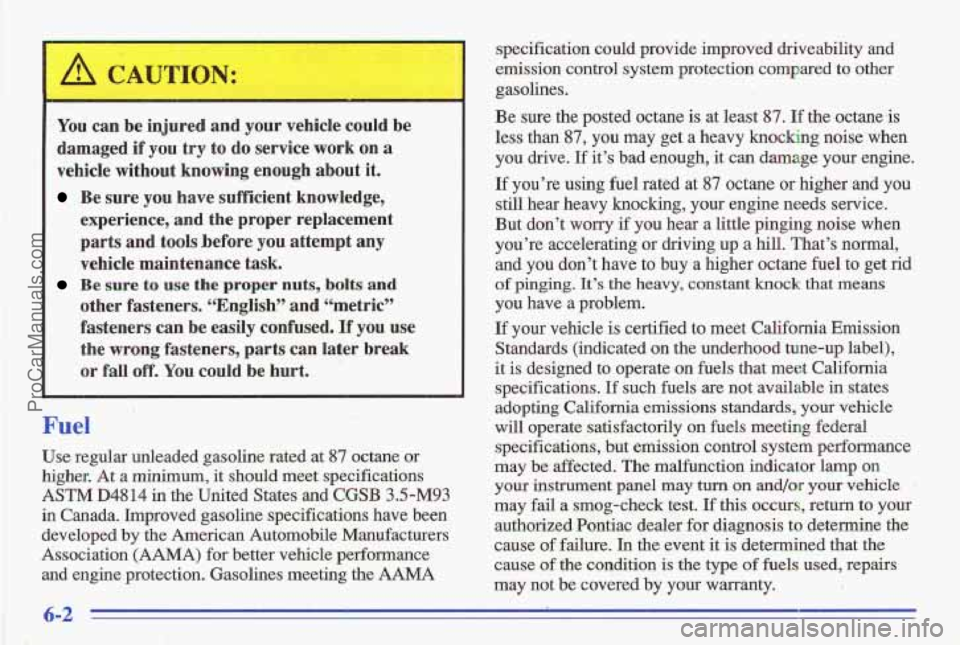
A CAUTION:
You can be injured and your vehicle could be
damaged if you try to do service work on a
vehicle without knowing enough about it.
Be sure you have sufficient knowledge,
experience, and the proper replacement
parts and tools before you attempt any
vehicle maintenance task.
Be sure to use the proper nuts, bolts and
other fasteners. “English” and “metric”
fasteners can be easily confused. If
you use
the wrong fasteners, parts can later break
or fall off. You could be hurt.
,, ~
Fuel
Use regular unleaded gasoline rated at 87 octane or
higher.
At a minimum, it should meet specifications
ASTM D4814 in the United States and CGSB 3.5-M93
in Canada. Improved gasoline specifications have been
developed by the American Automobile Manufacturers
Association
(AAMA) for better vehicle performance
and engine protection. Gasolines meeting the AAMA specification could provide improved driveability and
emission control system protection compared to other
gasolines.
Be ,sure the posted octane
is at least 87. If the octane-is
less
than 87, you may get a heavy knocking noise when
you drive. If it’s bad enough, it can damage your engine.
If you’re using fuel rated at 87 octane or higher and you
still hear heavy knocking, your’engine needs service.
But don’t worry if you hear a little pinging noise when
you’re accelerating
or driving up a hill. That’s normal,
and you don’t have to buy a higher octane fuel to get rid
of pinging. It’s the heavy, constant knock that means
you have a problem.
If your vehicle is certified to meet California Emission
Standards (indicated on
the underhood tune-up label),
it is designed to operate
on fuels that meet California
specifications. If such fuels
are not available in states
adopting California
emissions standards, your vehicle
will operate satisfactorily
on fuels meeting federal
specifications, but emission control system performance
may be affected. The malfunction indicator lamp
on
you instrument panel may turn on and/or your vehicle
may fail a smog-check test.
If this occurs, return to your
authorized Pontiac dealer for diagnosis to determine the
cause of failure.
In the event it is determined that the
cause
sf the condition is the type of fuels used, repairs
may not be covered
by your warranty.
ProCarManuals.com
Page 225 of 356
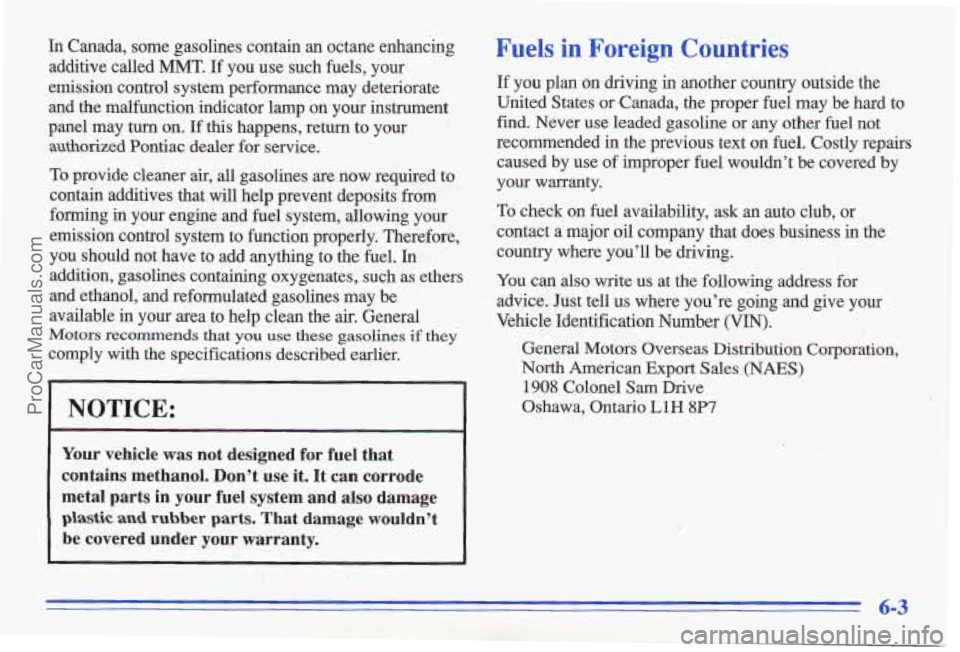
In Canada, some gasolines contain an octane enhancing additive called MMT.
If you use such fuels, your
emission control system performance may deteriorate and the malfunction indicator lamp on your instrument
panel may turn
on. If this happens, return to your
authorized
Pontiac dealer for service.
To provide cleaner air, all gasolines are now required to
contain additives that will help prevent deposits from
forming in your engine and fuel system, allowing your
emission control system to function properly. Therefore,
you should not have to add anything to the fuel.
In
addition, gasolines containing oxygenates, such as ethers
and ethanol, and reformulated gasolines may be
available
in your area to help clean the air. General
Motors recommends that you use these gasolines if they
comply with the specifications described earlier.
NOTICE:
Your vehicle was not designed for fuel that
contains methanol. Don’t use it. It can corrode
metal parts in your fuel system and also damage
plastic and rubber parts. That damage wouldn’t
be covered under your warranty.
Fuels in Foreign Countries
If you plan on driving in another country outside the
United States or Canada, the proper fuel may be hard to
find. Never use leaded gasoline
or any other fuel not
recommended in the previous text on fuel. Costly repairs
caused by use of improper fuel wouldn’t be covered by
your warranty.
To check on fuel availability, ask an auto club, or
contact a major oil company .that does business
in the
country where you’ll be driving.
You can also write us at the following address for
advice. Just tell us where you’re going and give your
Vehicle Identification Number
(VIN).
General Motors Overseas Distribution Corporation,
North American Export Sales .(NAES)
1908 Colonel Sam Drive
Oshawa, Ontario
L1H 8P7
ProCarManuals.com
Page 228 of 356
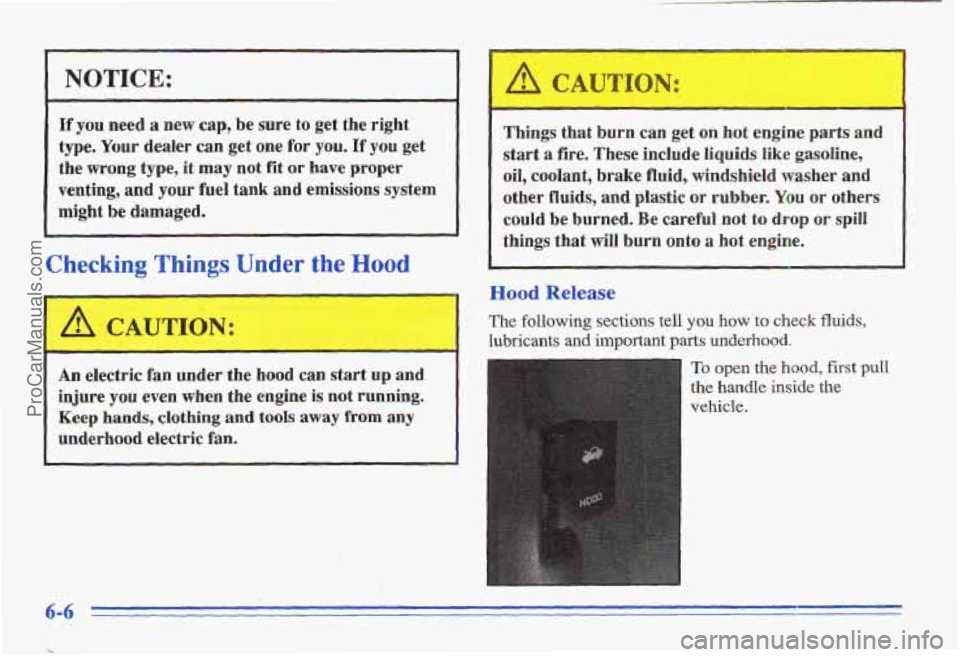
NOTICE:
If you need a new cap, b'e sure to get the right
type.
Your dealer can get one for you. If you get
the wrong type, it may not fit or have proper
venting, and your fuel tank and emissions system
might be
damaged.
Things that burn can get on hot engine parts and
start
a fire. These include liquids like gasoline,
oil, coolant, brake fluid, windshield washer and
other fluids, and plastic
or rubber. You or others
could b'e burned. Be
careful not to drop or spill
things
that will burn onto a hot engine.
Checking "'lings Under the Hood
r
An electric fan under the hood can start up and
injure
you even when the engine is not running.
Keep hands, clothing and tools away from any
underhood electric
fan.
The following sections tell you how to check fluids,
lubricants and important parts underhood.
TO open the hood, first pull
the handle inside the
vehicle.
ProCarManuals.com
Page 232 of 356
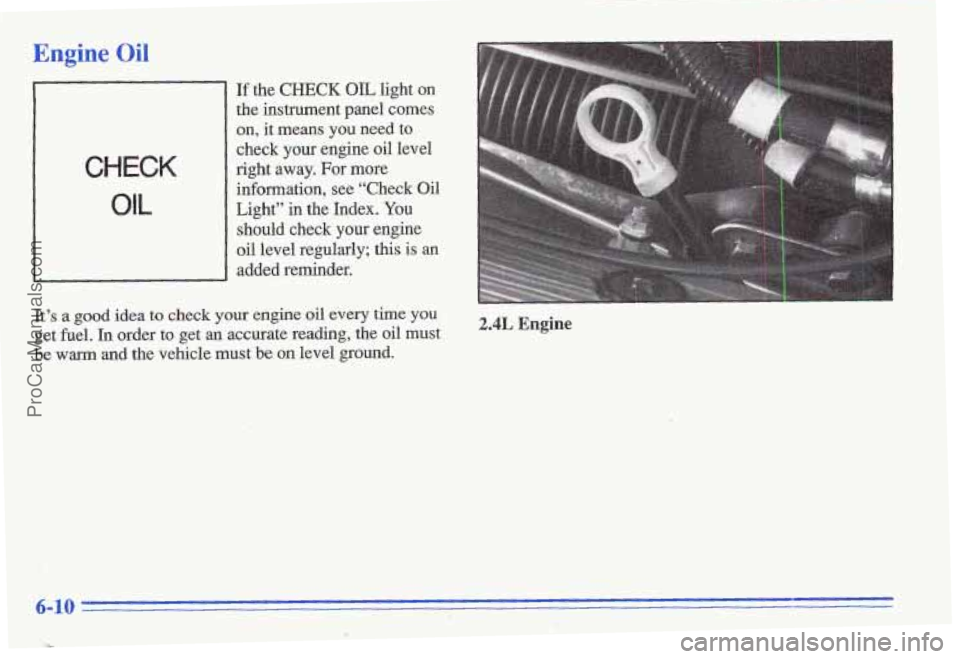
Engine Oil
CHECK
OIL
If the CHECK OIL light on
the instrument
panel comes
on,
it means you need to
check your engine oil level
right away. For more
information,
see “Check Oil
Light”
in the Index. You
should check your engine
oil
level regularly; this is an
added reminder.
It’s a good idea to check your engine oil every time you
get fuel. In order to get an accurate reading, the oil must 2.4L Engine
be warm and the vehicle must be on level ground.
6-10
k . 1
ProCarManuals.com
Page 233 of 356
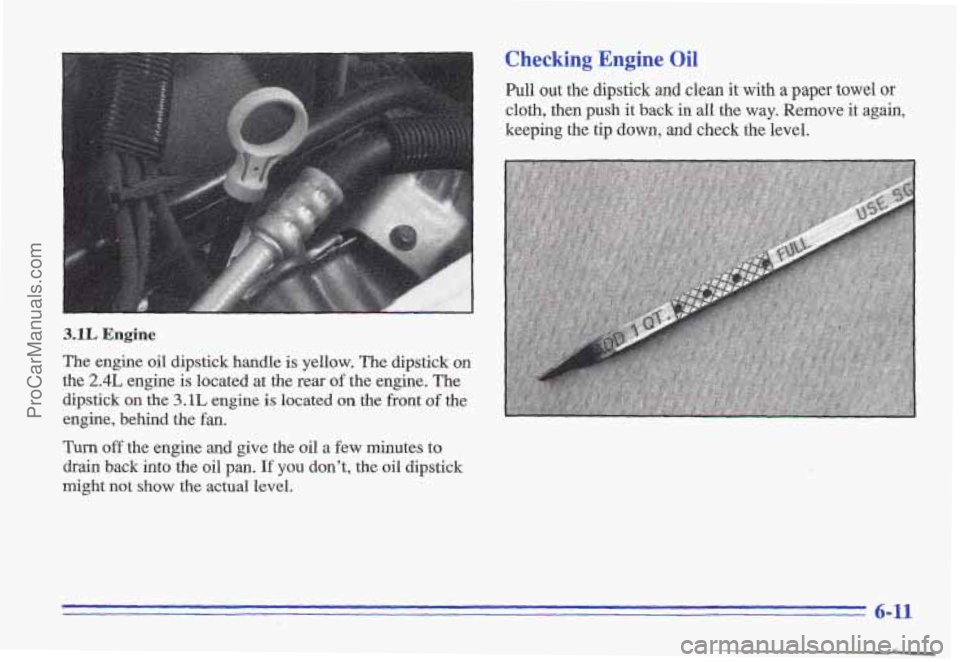
3.1L Engine
The engine oil dipstick handle is yellow. The dipstick on
the 2.4L engine is located at the rear of the engine. The
dipstick on
the 3.1L engine is located on the front of the
engine, behind the fan.
Turn off the engine and give the
oil a few minutes to
drain back into the oil pan.
If you don’t, the oil dipstick
might not show the actual level.
Checking Engine Oil
Pull out the dipstick and clean it with a paper towel or
cloth, then push it back in all the way. Remove it again,
keeping the tip down, and check the level.
6-11
I- ProCarManuals.com
Page 239 of 356
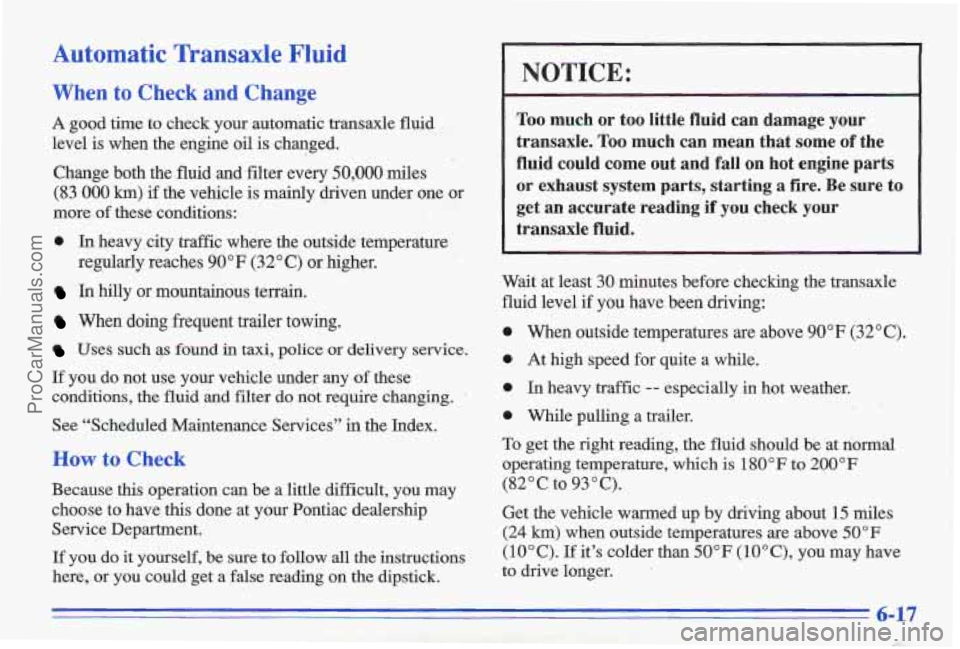
Automatic Transaxle Fluid
When to Check and Change
A good time to check your automatic transaxle fluid
level is when the engine oil is changed.
Change both the fluid and filter every
50,000 miles
(83 000 km) if the vehicle is mainly driven under one or
more of these conditions:
0 In heavy ,city traffic where the outside, temperature
In hilly or mountainous terrain.
When doing frequent trailer towing.
Uses such zp found in taxi, police or delivery service.
If you do not use your vehicle under any of these
conditions, the fluid and
filter do not require changing.
See “Scheduled Maintenance Services”
in the Index.
How to Check
Because this operation can be a little difficult, you may choose to have this done at your Pontiac dealership Service Department.
If you do it yourself, be sure to follow all the instructions
here, or
you could get a false reading on the dipstick.
regularly reaches
90°F (32°C)
or higher.
NOTICE:
Too much or too little fluid can damage your
transaxle.
Too much can mean that some of the
fluid could come out and fall on hot engine parts
or exhaust system parts, starting a fire. Be sure to
get an accurate reading if you check your
transaxle fluid.
Wait at least 30 minutes before checking the transaxle
fluid level
if you have been driving:
0 When outside temperatures are above 90°F (32°C).
0 At high speed for quite a while.
0 In heavy traffic -- especially in hot weather.
0 While pulling a trailer.
To get the right reading, the fluid should be at normal
operating temperature, which
is 180°F to 200°F
(82°C to 93°C).
Get the vehicle warmed up by driving about 15 miles
(24 krn) when outside temperatures are above 50°F
(10°C). If it’s colder than 50°F (lO°C), you may have
to drive longer.
ProCarManuals.com
Page 240 of 356
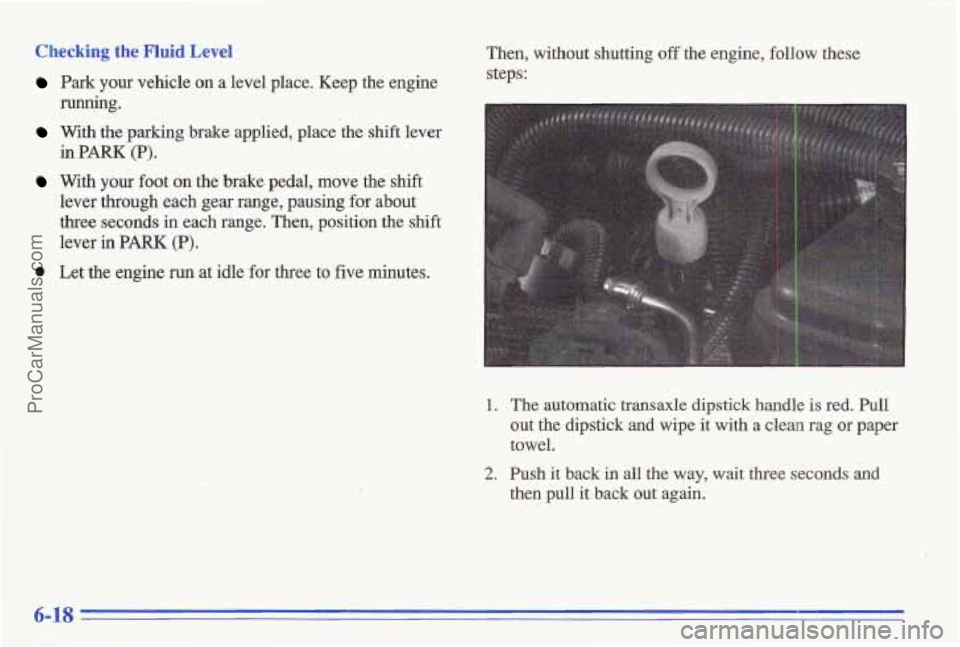
Checking the Fluid Level
' Park your vehicle on a level place. Keep the engine
running.
With the parking brake applied, place the shift lever
in
PARK (P). I
With your foot on the brake pedal, move the shift
lever through each
gear range, pausing for about
three seconds in each range. Then, position the shift
lever in PARK (P).
0 Let the engine run at idle for three to five minutes. Then,
without shutting
off the engine, follow these
steps:
1. The automatic transaxle dipstick handle is red. Pull
out the dipstick
and wipe it with a clean rag or paper
towel.
2. hsh it back in all the way, wait three seconds and
then pull it back out again.
6-18
ProCarManuals.com
Page 242 of 356
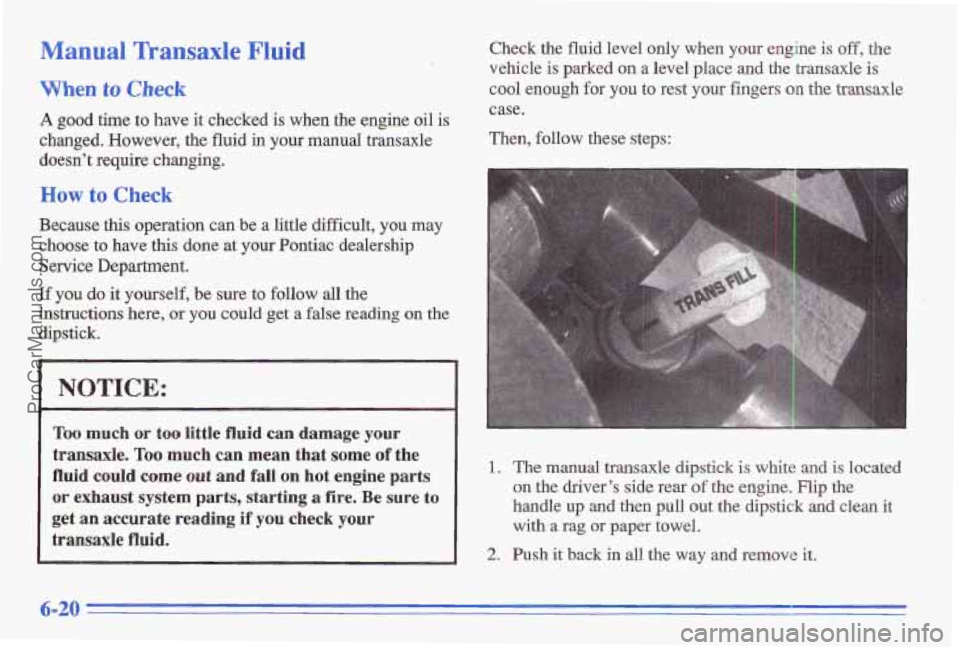
Manual Transaxle Fluid
When to Check
Check the fluid level only when your engine is off, the
vehicle
is parked on a level place and the transaxle is
cool enough for
you to rest your fingers on the tJransaxle
A good time to have it checked is when the engine oil. is
changed. However, the fluid in your manual transaxle Then, foll\
ow these steps:
doesn't require
changing.
case.
How to Check
Because this operation can b'e a little difficult, you may
choose to have this done at your Pontiac dealership
Service Department.
iG Jf you do it yourself, be sure to follow all the , .,..!%$i- k%4nstructions here, or you could get a false reading on the
,> , . ".
dipstick.
I
NOTICE:
Too much or too little fluid can damage your
transaxle. Too much can mean that some of the
fluid
could come out and fall on hot engine parts
or exhaust system parts, starting a fire. Be sure to
get an accurate reading if you check yuur
transaxle fluid.
1, The manual transaxle dipstick is white and is located
on the driver's side rear of the engine. Flip the
handle up and then pull out the dipstick and clean it
with a rag or paper towel.
2. Push it back in all the way and remove it.
6-20
ProCarManuals.com
Page 244 of 356
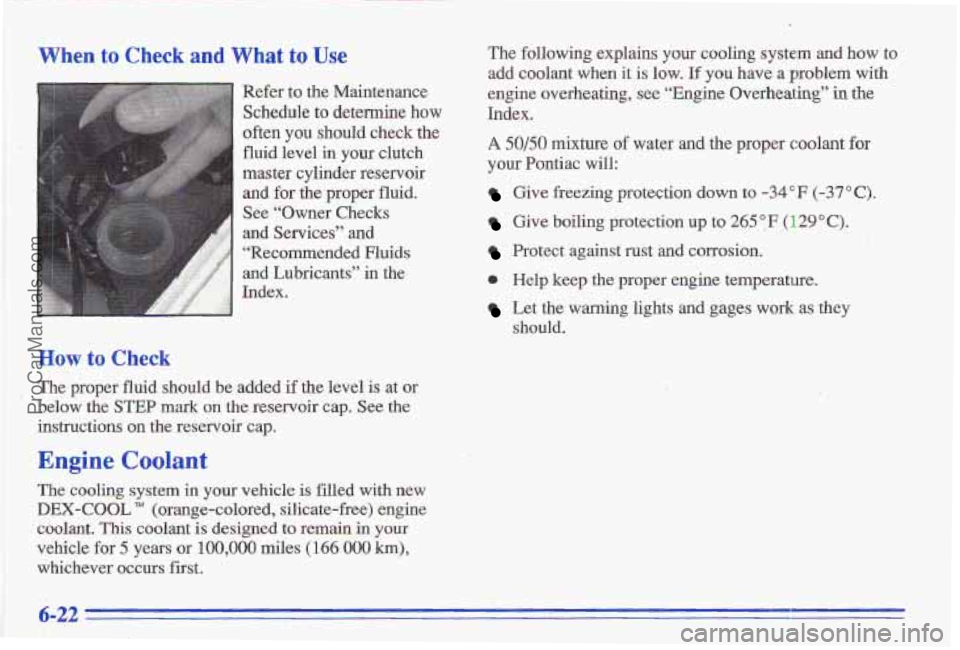
When to Check and What to Use
Refer to the Maintenance
Schedule
to determine how
often you should check the
fluid level
in your clutch
master cylinder reservoir and for
the proper fluid.
See “Owner Checks
and Services” and
“Recommended Fluids
and Lubricants” in the
How tu Check
The proper fluid should be added if the level is at or
below the
STEP mark on the reservoir cap. See the
instructions
on the reservoir cap.
Engine Coolant
The cooling system in your vehicle is filled with new
DEX-COOL TM (orange-colored, silicate-free) engine
coolant.
This coolant is designed to remain in your
vehicle
for 5 years or 100,000 miles (166 000 h),
whichever occurs first. The
following explains
your cooling system and how to
add coolant when it is low. If you have a problem with
engine overheating, see “Engine Overheating”
in the
Index.
A Sol50 mixture of water and the proper coolant for
your Pontiac will:
Give freezing protection down to -34°F (-37°C).
Give boiling protection up to 265 9 F ( 129 O C).
Protect against rust and corrosion.
0 Help keep the proper engine temperature.
Let the warning lights and gages work as they
should.
6-22
ProCarManuals.com
Page 246 of 356
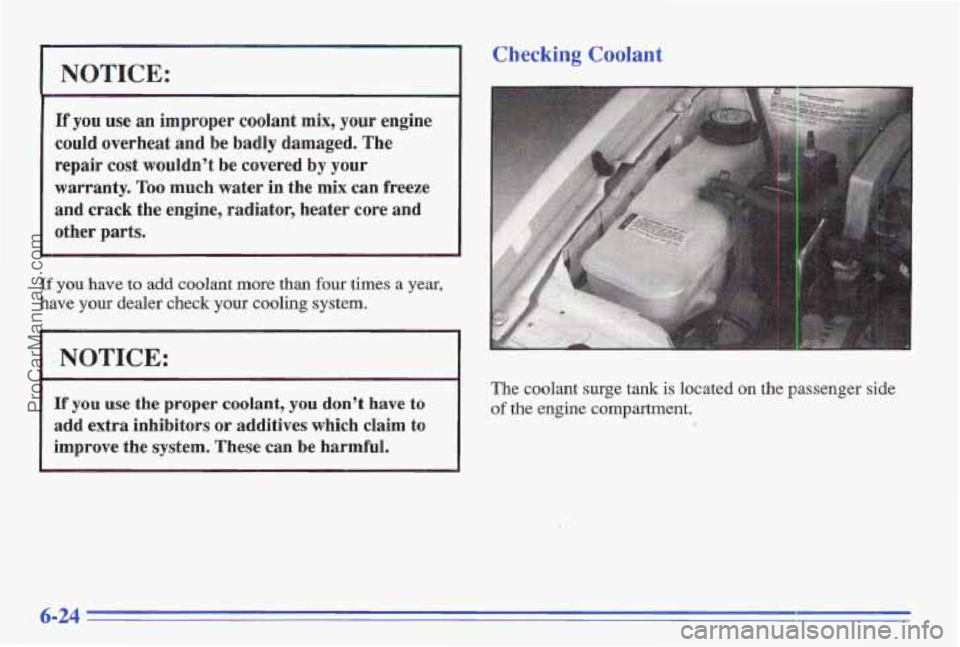
NOTICE:
If you use an improper coolant mix, your engine
could overheat and be badly damaged. The
repair cost wouldn’t be covered by your
warranty. Too much water
in the mix can freeze
and crack the engine, radiator, heater core and
other parts.
If you have to add cooldnt more than four times a year,
have
your dealer check your cooling system,
I NOTICE:
If you use the proper coolant, you don’t have to
add extra inhibitors or additives which claim to
improve the system. These can be harmful.
Checking Coolant
The coolant surge tank is located on the passenger side
of the engine compartment.
0
ProCarManuals.com